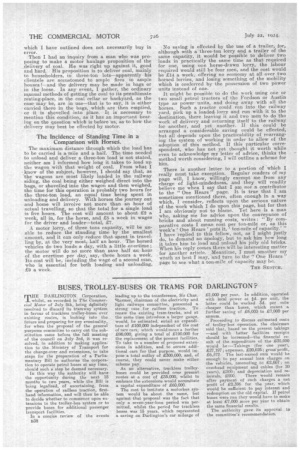BUSES, TROLLEY-BUSES OR TRAMS FOR DARLINGTON?
Page 20

If you've noticed an error in this article please click here to report it so we can fix it.
THE DARLINGTON Corporation, whilst, as recorded in The Commercial Motor of July 8th, being dgfinitely resolved to discard its tramway system in favour of trackless trolley-buses over existing routes, is looking into the future and preparing for any eventuality, for when the proposal of the general purposes committee to carry out the substitution came before the full meeting of the council on July 3rd, it was resolved, in addition to making application to the Ministry of Transport for the change-over and extensions, to take steps for the preparation of a Parliamentary Bill to authorize the corporation to operate petrol buses at any time, should such a step be deemed necessary.
In this way the authority will have the opportunity during the next 18 months to two years, while the Bill is being legalized, of ascertaining, from the operation of railless traction, firsthand information, and will then be able to decide whether to commence upon extensions to the trolley-bus system or to provide buses for additional passenger transport facilities.
In a concise review of the events B38
leading up to the transference, Sir Chas. qtarmer, chairman of the electricity and light railways committee, presented a strong case for railless traction. To renew the existing tram-tracks, and at the same time introduce a larger gauge, would, he estimated, entail an expenditure of £100,000 independent of the cost of new cars, which would mean a further £90,000, giving a total of £190,000 for the replacement of the present facilities. To take in a number of proposed extensions in addition, and to secure additional cars for that purpose, would impose a total outlay of £300,000, and, of course, they could never make either scheme pay.
As an alternative, trackless trolleybuses could be provided over present routes at a cost of £35,000, whilst to embrace the extensions would necessitate a capital expenditure of £64,000.
The cost to institute a motorbus system would be about the same, but against that proposal was the fact that only a seven-year-loan period was permitted, whilst the period for trackless buses was 15 years, which represented a saving on Darlington's car mileage of
21,000 per year. In addition, operated with local power at id. per unit, the latter could be worked ad. per mile cheaper than buses, which meant a further saving of 26,000 to £7,000 per annum.
Proceeding to discuss estimated costs of trolley-bus operation, the chairman said that, based on the present takings —and with better facilities receipts should be increased—the, financial result of the expenditure of the £35,000 would be :—Takings for one year), £27,197; expenses, £20,625; gross profit, 26,572 The last-named sum would he enough to pay annual loan charges on the vehicles, amounting to £2,667; on overhead equipment and cables (for 20 years), 2500; and depreciation and re
newals, 2900. There would remain after payment of such charges a net profit of 22,396 for the year, which would he sufficient to pay interest, and redemption on the old capital. If petrol buses were run they would have to make at least 27,000 more per year to obtain the same financial results.
The authority gave its approval to the committee's recommendation.






























